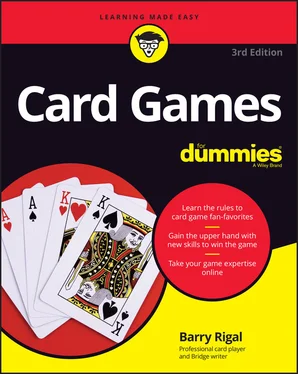Old Maid allows you to keep card strategy and psychology simple, making it an ideal game for younger children.
 All you need to play Old Maid is the following:
All you need to play Old Maid is the following:
At least three players: There is no real upper limit, if you have enough decks of cards.
One or more standard decks of 52 cards, with three queens removed: Use a single deck of cards for up to six players. For seven or more players, use two decks, but take care that the decks have the same markings. You can play the game with special commercial decks, too, with animal faces on the cards and just one Donkey in the deck. You can also play with a special Old Maid deck, with one ugly Old Maid card.
The object of Old Maid is to get rid of all the cards in your hand without being left with the one unmatched card, the solitary queen, or Old Maid.
The dealer deals out all the cards, one by one and face-down, in a clockwise rotation. You start by removing every pair of cards that you have (a pair can be two 5s or two kings, for example). You set these cards aside face-up on the table so that everyone can see how many pairs you have.
 Take care not to remove any three of a kind — only remove pairs from your hand.
Take care not to remove any three of a kind — only remove pairs from your hand.
After the removal of pairs, the player to the left of the dealer fans out their cards face-down on the table, and the player to their left takes one card. The player who’s offered the cards must take one of them, and then they look at it to see whether it forms a pair with another card in their hand. If it does, they discard the pair onto the tabletop.
Whether the card they draw forms a pair or not, the second player spreads their cards face-down and offers their hand to the player on their left, who must then choose a card.
The game continues, with players dropping out as they get rid of all their cards. Eventually, one player gets left with the lone queen, and other players torment that player with taunts of “Old Maid!” until a new hand starts.
 Both France and Germany feature special versions of Old Maid. In France, they take out three jacks from the deck, leaving only the ♠J: the vieux garçon or “Old Boy.” The Germans have special decks with a Black Peter card, often showing a cat in military attire. In each game, the loser is the player left with the odd card.
Both France and Germany feature special versions of Old Maid. In France, they take out three jacks from the deck, leaving only the ♠J: the vieux garçon or “Old Boy.” The Germans have special decks with a Black Peter card, often showing a cat in military attire. In each game, the loser is the player left with the odd card.
 You can use a certain element of psychology or reverse psychology to persuade people to take the lone queen away from you. If you arrange your cards with some paired up and more prominently positioned than others, the next player may think that you want to pass off the prominent cards. Make sure that the prominent cards are “safe” ones, so you increase the chance that the player takes one of the other cards — perhaps the queen.
You can use a certain element of psychology or reverse psychology to persuade people to take the lone queen away from you. If you arrange your cards with some paired up and more prominently positioned than others, the next player may think that you want to pass off the prominent cards. Make sure that the prominent cards are “safe” ones, so you increase the chance that the player takes one of the other cards — perhaps the queen.
As its alternative name suggests, Spit is a game where fast reactions are critical. In fact, Spit is rare in that the players don’t take turns in sedate fashion to follow suit in turn. Instead, each player makes the effort to play as quickly as possible, not waiting for their opponent.
 To play Spit, you need:
To play Spit, you need:
Two players
One deck of cardsI suggest you keep a special deck for this game; after one session your cards may never be the same again.
The object of the game is to get rid of all your cards as quickly as possible. The dealer shuffles the cards and deals each player 26 cards.
Each player then deals out 15 of their 26 cards into a triangle — one pile with five cards, one with four, one with three, one with two, and one with a single card. The piles that form the triangle are called the stock piles. On each of the piles, you turn the top card over. That leaves you a pile of 11 cards, which you leave face-down and don’t look at. This is your draw pile, or spit cards.
 Some people play with only four stock piles that fill with four cards, three cards, two cards, and one card.
Some people play with only four stock piles that fill with four cards, three cards, two cards, and one card.
After each player sets up the spit cards and stocks, all players call out “Spit!” and turn over the top cards of their piles of 11, putting them in the middle of the table. These two cards make up the two spit piles. The slugfest is about to begin. Using only one hand (playing cards with both hands is forbidden), you attempt to get rid of the cards from your stock piles onto the spit piles before your opponent can do so.
Legal moves involve playing a face-up card from your stock piles on to the spit piles. You can play a card if it’s one rank higher or one rank lower than the card on the top of the spit piles, and aces count as high or low, so you can put them on a king or a 2. Suits are irrelevant for the purposes of this game.
 Some people play that the cards you play on the spit piles must alternate in color (you must play a red king on a black queen or ace, for example).
Some people play that the cards you play on the spit piles must alternate in color (you must play a red king on a black queen or ace, for example).
 When you exhaust a pile, you can move a face-up card from any pile to fill the gap. You can never have more than five piles, come what may.
When you exhaust a pile, you can move a face-up card from any pile to fill the gap. You can never have more than five piles, come what may.
 Some people play that if you have two cards of the same rank on the top of different stock piles, you can move one of them on top of the other, thereby creating an additional option and making a blank space to allow you to bring another card down.
Some people play that if you have two cards of the same rank on the top of different stock piles, you can move one of them on top of the other, thereby creating an additional option and making a blank space to allow you to bring another card down.
When neither player can make a legal move, the first phase of the game has ended, and you’re ready for the second phase, which essentially repeats phase one.
In phase two, each player simultaneously calls out “Spit!” again, turning over the top cards from their spit cards face-up onto the already existing spit piles. The game continues, with both players trying to get rid of their stock piles as quickly as possible. Eventually, one of three situations occurs:
You get rid of all your stock cards; let’s call this event the end of a round. When this happens, you have your choice of spit piles, and you’ll naturally take the smaller one. The second player takes the other pile, and you both collect your unplayed cards, shuffle them all together, and lay them out in the traditional format. An alternative is that when a player gets rid of all their cards, both players can reach for the spit piles, and whoever has the fastest reflexes gets the choice. I prefer the standard rule, however; it seems right to reward the player who plays better in the first stage.
Both players get rid of all their spit cards, and neither player can play a card. In this case, whoever has fewer stock cards left gathers up all their cards and adds the smaller spit pile to them, leaving their rival to add the other pile.
Читать дальше

 All you need to play Old Maid is the following:
All you need to play Old Maid is the following: Take care not to remove any three of a kind — only remove pairs from your hand.
Take care not to remove any three of a kind — only remove pairs from your hand. Both France and Germany feature special versions of Old Maid. In France, they take out three jacks from the deck, leaving only the ♠J: the vieux garçon or “Old Boy.” The Germans have special decks with a Black Peter card, often showing a cat in military attire. In each game, the loser is the player left with the odd card.
Both France and Germany feature special versions of Old Maid. In France, they take out three jacks from the deck, leaving only the ♠J: the vieux garçon or “Old Boy.” The Germans have special decks with a Black Peter card, often showing a cat in military attire. In each game, the loser is the player left with the odd card. You can use a certain element of psychology or reverse psychology to persuade people to take the lone queen away from you. If you arrange your cards with some paired up and more prominently positioned than others, the next player may think that you want to pass off the prominent cards. Make sure that the prominent cards are “safe” ones, so you increase the chance that the player takes one of the other cards — perhaps the queen.
You can use a certain element of psychology or reverse psychology to persuade people to take the lone queen away from you. If you arrange your cards with some paired up and more prominently positioned than others, the next player may think that you want to pass off the prominent cards. Make sure that the prominent cards are “safe” ones, so you increase the chance that the player takes one of the other cards — perhaps the queen. When you exhaust a pile, you can move a face-up card from any pile to fill the gap. You can never have more than five piles, come what may.
When you exhaust a pile, you can move a face-up card from any pile to fill the gap. You can never have more than five piles, come what may.










